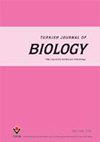FRET-based characterization of K264A, D345A, and Y335Amutants in the human dopamine transporter
IF 0.9
4区 生物学
Q3 BIOLOGY
引用次数: 0
Abstract
The dopamine transporter (DAT) plays a role in the termination of dopaminergic neurotransmission; thereby it is accepted as the primary target of various psychostimulants. N-terminal phosphorylation of DAT has been proposed as a regulator in different DAT functions, such as amphetamine-induced efflux or PKC/PKA-mediated responses. To understand the role of N-terminal conformational changes in dopamine transporter structure and function, the fluorescence resonance energy transfer (FRET) method was applied to various DAT constructs fluorescently labeled at the N-terminus and substrate-induced conformational changes were determined using rhodamine-labeled cocaine analog JHC1-64 in three DAT mutants. The results indicated that the construct with YFP inserted into the N-terminal position-55 displayed effective interaction with the substrate and simultaneous mutation of two serine residues (S7 and S12) to alanine or aspartic acid demonstrated similar phenotypes as their wild-type (WT) counterparts. FRET was detectable for N-terminal p55 YFP WT, Ser/Ala, and Ser/Asp forms, but there was no significant difference among the three mutants, contrary to our expectations based on the previously proposed roles of these serine residues. In addition, three mutants (K264A, D345A, and Y335A) implemented in the position-55 YFP background were also investigated and the importance of Y335 in the translocation cycle and in the process of substrate release was verified.基于FRET的人类多巴胺转运蛋白中K264A、D345A和Y335 Amutants的表征
多巴胺转运蛋白(DAT)在多巴胺能神经传递的终止中发挥作用;从而被接受为各种精神刺激剂的主要靶点。DAT的N-末端磷酸化被认为是不同DAT功能的调节因子,如苯丙胺诱导的外排或PKC/PKA介导的反应。为了了解N-末端构象变化在多巴胺转运蛋白结构和功能中的作用,将荧光共振能量转移(FRET)方法应用于在N-末端荧光标记的各种DAT构建体,并使用罗丹明标记的可卡因类似物JHC1-64在三个DAT突变体中测定底物诱导的构象变化。结果表明,将YFP插入N-末端位置-55的构建体显示出与底物的有效相互作用,并且两个丝氨酸残基(S7和S12)同时突变为丙氨酸或天冬氨酸显示出与其野生型(WT)对应物相似的表型。FRET可检测到N-末端p55-YFP-WT、Ser/Ala和Ser/Asp形式,但三种突变体之间没有显著差异,这与我们基于这些丝氨酸残基先前提出的作用的预期相反。此外,还研究了在55位YFP背景中实现的三个突变体(K264A、D345A和Y335A),并验证了Y335在易位周期和底物释放过程中的重要性。
本文章由计算机程序翻译,如有差异,请以英文原文为准。
求助全文
约1分钟内获得全文
求助全文
来源期刊

Turkish Journal of Biology
BIOLOGY-
CiteScore
4.60
自引率
0.00%
发文量
20
审稿时长
6-12 weeks
期刊介绍:
The Turkish Journal of Biology is published electronically 6 times a year by the Scientific and Technological
Research Council of Turkey (TÜBİTAK) and accepts English-language manuscripts concerning all kinds of biological
processes including biochemistry and biosynthesis, physiology and metabolism, molecular genetics, molecular biology,
genomics, proteomics, molecular farming, biotechnology/genetic transformation, nanobiotechnology, bioinformatics
and systems biology, cell and developmental biology, stem cell biology, and reproductive biology. Contribution is open
to researchers of all nationalities.
 求助内容:
求助内容: 应助结果提醒方式:
应助结果提醒方式:


